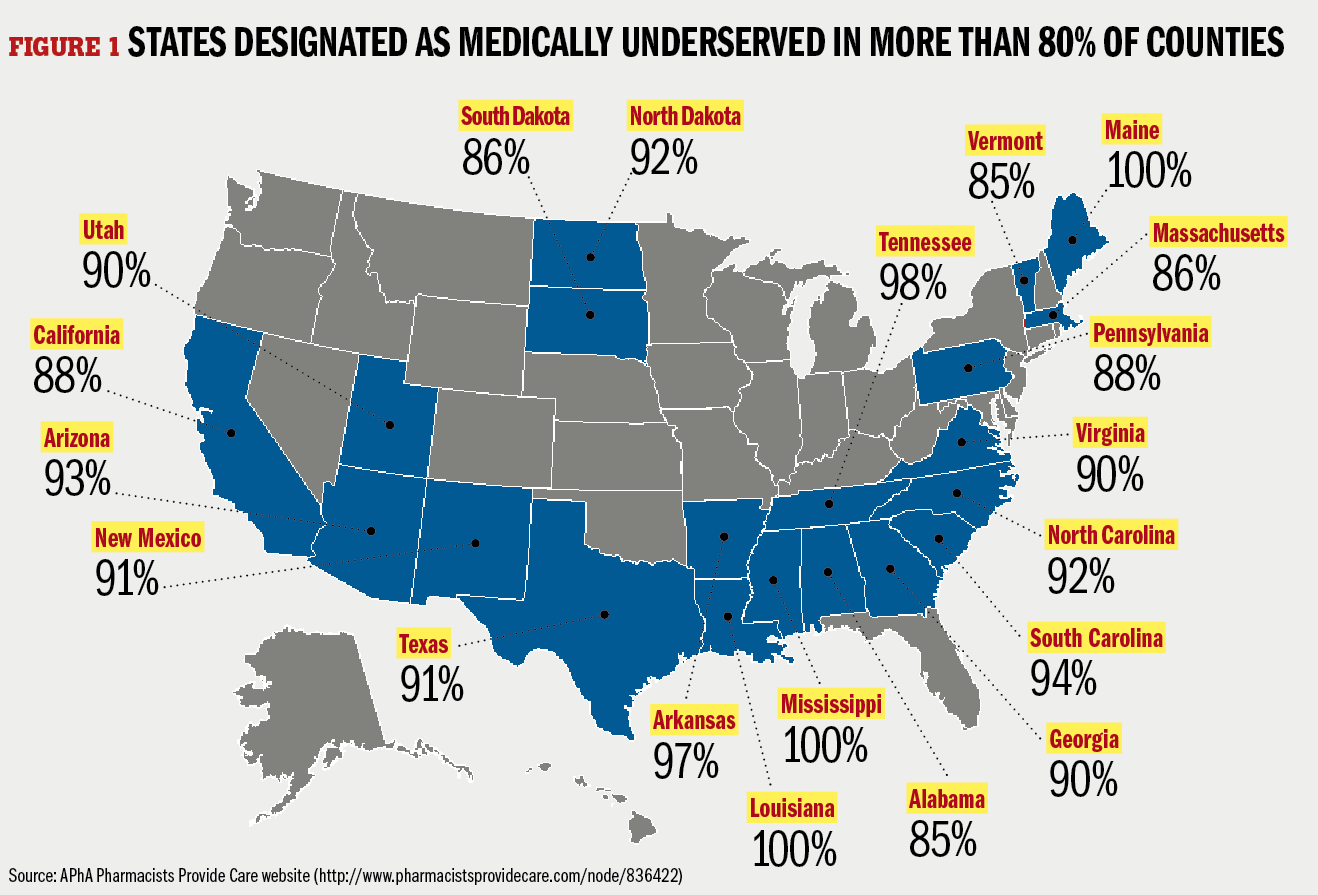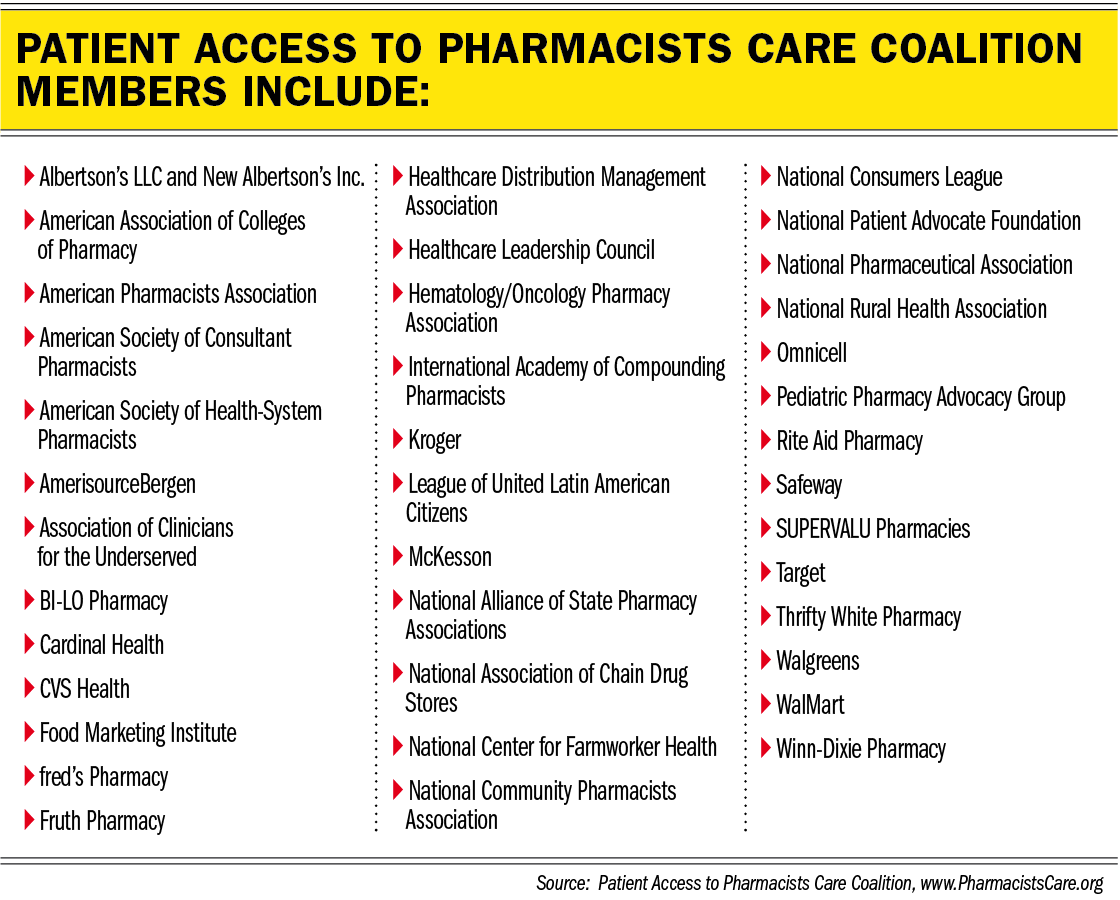Provider status
With provider status now a reality in 38 states, HR 592 and S 314 have powerful Congressional support. How long before the payers come on board?
Provider status for pharmacists is no longer a dream. It is already a reality in 38 states, 76% of the nation. All but two states allow collaborative practice agreements that effectively expand pharmacistsâ scope of practice. Between 70 and 80 different pieces of legislation to expand provider status are currently working their way through state legislatures.
On the federal side, 282 of 425 Representatives have signed on as co-sponsors of âThe Pharmacy and Medically Underserved Areas Enhancement Act,â HR 592. The Senate companion bill, S 314, has 42 co-sponsors. The bill would add pharmacists to the list of healthcare providers designated under Medicare Part B. Most federal programs as well as many state and private payers use the Part B list in designating providers for their own purposes.
See also: Pharmacist provider status gains traction
Whatâs the holdup?
So why arenât more pharmacists getting paid for their professional services? Provider status is a necessary step in achieving payment status, but it is only the first step.
âYou can give us provider designation all you want, but until large payers in the marketplace act on it, not much is going to change,â said Mike Schwab, executive vice president of the North Dakota Pharmacists Association.
âThatâs why it is so important to keep building the pressure and the momentum at both the state and federal levels. We are seeing state Medicaid programs, even some private insurers, starting to pay pharmacists as providers. What we need at this point is for one of the big players in the market, whether it is a PBM or an insurer, to recognize the value pharmacists can bring to the patient-care process. Federal provider status will help underline that position, but it doesnât mean the doors will suddenly fly open. This is something we all have to keep working at, one state, one legislator, one payer at a time.â
See also: Provider status: Important to pharmacists, critical to patients
North Dakota is one of several states that has moved the bar on both provider status and payment status in the last year.
The state pharmacy association worked with physician groups, state regulatory boards, and the state pharmacy school to expand collaborative-practice agreement provisions and point-of-care testing. Pharmacists in North Dakota can now perform about two dozen point-of-care tests and prescribe appropriate drug therapy in a single pharmacy visit.
The state also requires its Medicaid program to pay for pharmacist management of hepatitis C and asthma patients starting in July 2016. Minnesota, Nebraska, Ohio, Washington, and other states are also rolling out new statutory and regulatory language to designate pharmacists as healthcare providers and to require that they be paid as providers under certain circumstances.

Two access models
From APhAâs perspective, provider status means improved patient access to healthcare services provided by pharmacists and payment for pharmacists who provide that care. Results from a 2015 survey of pharmacist-provided services describe two distinct pathways to access.
The community pharmacy pathway represents the tens of thousands of community pharmacists working in independent, mass merchandiser, chain, and supermarket pharmacies. These pharmacists and pharmacies serve geographically defined communities.
Services are generally available without an appointment, are aligned with the provision of prescription drugs, and are focused around a pharmacist working in the community.
Pharmacists in these community settings are central to the medication-use process and are the healthcare professionals most often seen by many patients. About 95% of the U.S. population lives within five miles of a pharmacy. In many rural and urban settings, a pharmacist may be the only healthcare professional within reach.
Community pharmacists provide the opportunity to teach and coordinate self-care behaviors that support prescribed therapies, including over-the-counter products and nutritional supplements. For patients seeing multiple prescribers, community pharmacy can strengthen the continuity and coordination across providers and settings that will improve the safety, effectiveness, and quality of chronic care.
The integrated health organization pathway represents acute care, inpatient hospital, ambulatory care clinic, health system and outpatients, long-term care, integrated delivery systems, and physician office populations with very targeted needs. These integrated care systems often embed pharmacists in office practice settings as part of a team-based care model. Integrated organizations typically align provider behavior with payer goals for quality metrics and pay-for-performance targets.
Pharmacists in these integrated settings are central to appropriate medication use in circumstances involving acute care, disease management, and targeted outcomes. Integrated care pharmacists help optimize resource use and provide medication-centered expertise, as well as facilitate continuous quality improvement efforts.
A welter of payment approaches
The situation on the ground is far more complex and confusing. Pharmacists may practice in two broad settings, community and integrated organizations, but the details are anything but clear.
Healthcare in the United States is fractured across state lines and split into multiple jurisdictions and programs at the federal and state levels, with a mix of payers in the public and private sectors.
Responsibilities for providing and regulating care are typically separated from payment for care. Just as PBMs may or may not cover prescriptions as written, other payers may or may not agree to cover care that providers deem medically necessary and appropriate.

Stacie MaassâThere is not just one answer to provider status,â said Stacie Maass, BSPharm, JD, senior vice president for Pharmacy Practice and Government Affairs at the American Pharmacists Association. âFederal legislation overly covers the Medicare population, about 20% of the total U.S. population. That leaves 80% of the population covered by Medicaid and private insurers. While federal legislation is important, there is still that other 80%. Federal legislation is impactful, but it is not the only pathway.â
The federal bill would confer provider status upon pharmacists serving Medicare patients in medically underserved areas: areas with medically underserved populations or with a shortage of healthcare professionals.
âMedically underservedâ may sound limiting, Maass said, but it includes all 50 states. At least 21% of counties in every state have medically underserved areas, and 81% to 100% of counties in 20 states have medically underserved areas.
The current status of the federal bill and pharmacist resources can be found online at www.PharmacistsProvideCare.com.
Partners in team-based care
âWe are not trying to take on primary care. We do not want to take on what physician assistants and nurse practitioners currently do,â said Maass. âWe are trying to partner with them in team-based care. There are not enough providers in those areas to meet the needs of patients today.â
Support for provider status is being channeled through the Patient Access to Pharmacists Care Coalition (www.PharmacistsCare.org). Most PAPCC members are pharmacy-centered, but a growing number of patient groups are joining the effort.

According to Maass, who outlined the improving outlook for provider status at the APhA annual meeting in Baltimore earlier this year, federal legislation enjoys strong bipartisan support in Congress, but the window for passage in a presidential election year is tight.
âIn conversations on the Hill, everyone talks about pharmacists,â she said. âPharmacists are very high in public perception. But policy-makers still have a perception of pharmacists and their role in dispensing. They donât realize the amount of education pharmacists have; they donât see our training, our education, and our very successful collaborations with other providers.â
APhA is using a targeted digital media campaign to help bring policy-makersâ outdated view of pharmacy into the 21st century. It helps that the Centers for Medicare and Medicaid Services (CMS) is focusing on pharmacy services. Even without the Part B designation of pharmacists as providers, CMS is encouraging Part D plans to provide more than minimal medication therapy management (MTM), which means bringing more pharmacists into direct patient care.
The Joint Commission of Pharmacy Practitioners has already developed a uniform practice model, the âPharmacistsâ Patient Care Process,â which can be used in any practice setting and any scope of practice.
In addition to their in-depth knowledge of medications, pharmacists must also have a background in the biomedical, sociobehavioral, and clinical sciences, along with the ability to apply evidence-based principles to pharmacy practice.
Widespread support, mostly
There is little overt opposition to provider status. Yet.
No real opposition to provider status has emerged, said Maass, in part because the bill has yet to be scored by the Congressional Budget Office. The scoring process includes an estimate of the net cost of proposed legislation. In order to become law, other programs would have to be cut to offset any expected increase in spending.
"Any bill moving through Congress must identify offsets to pay for it," Maass said. "When the time comes to target other programs for offsets is when opposition begins to mount."
The health insurance industry is not taking a public position on pharmacist provider status. The industry trade association, America's Health Insurance Plans, did not respond to requests for comment.
States generally like the idea of getting more pharmacists more involved in direct patient care.
The National Governor's Association (NGA) issued a white paper in 2015, "The Expanding Role of Pharmacists in a Transformed Health System." NGA advised states to allow pharmacists to perform MTM services, for example, to improve outcomes and reduce costs, and to integrate pharmacists into provider programs.
State considerations
For states, provider status is a dollars-and-cents issue.

Dan Crippen
"States can have a major impact on healthcare by increasing the supply of providers," said Dan Crippen, former NGA executive director. "Pharmacists are very much a part of that discussion. As we spend more on chronic diseases, somebody needs to be in charge of sorting out these complex and sometimes conflicting medication regimens and programs. Who better than pharmacists? We have already seen that pharmacist involvement in patient care can cut hospital readmission rates by 46%. I hope pharmacists will help us get that message out to their states."
State associations are trying. California granted provider status to pharmacists in 2013, although payers have been slow to come on board.
Washington state avoided similar issues by requiring private payers who cover services provided by physicians, nurse practitioners, and other providers to include pharmacists in provider networks. Provider-status compensation began in hospitals and ambulatory care clinics this year, and will include all settings in 2017.

Carmen CatizoneState boards of pharmacy support provider status. As states such as California and Washington add pharmacists to their own provider lists, many more states are moving in the same direction by expanding collaborative practice agreements.
"We are trying to clear through state practice acts any barriers that could impact federal provider status," said Carmen Catizone, MS, RPh, executive director of the National Association of Boards of Pharmacy. "There are no barriers at the board of pharmacy level that I have heard of."
On the front lines
Immunizations helped open the door to direct patient services in many states, Catizone said. The rising tide of opioid overdose and naloxone rescue treatment is putting pharmacists on the front lines of patient care in many states.
West Virginia has the nation's highest rate of opioid-overdose deaths, and pharmacists are taking a leading role in getting naloxone to those who are at highest risk. Using that expertise and recognition to open broader patient-care opportunities is an obvious next step, said Richard Stevens, executive director of the West Virginia Pharmacists Association.
The state recently created a new nursing category, Advanced Practice Registered Nurses. APRNs can practice independently and prescribe any medications except Schedule II products. Pharmacists are next in line for independent practice and prescribing authority.
"There is a clear need for more providers, especially in rural areas, which is most of West Virginia," Stevens said. "We are going to see an expansion in the scope of practice for pharmacists. At the same time, we want to maintain our good working relationship with the board of medicine and the medical community. We see success by moving deliberately and cautiously, and convincing the medical community of the need for the provision of services by pharmacists and for the quality of the care we can provide."